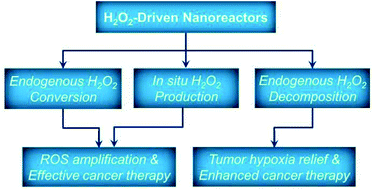Fabrication of H2O2-driven nanoreactors for innovative cancer treatments
Abstract
The increased production of hydrogen peroxide (H2O2) is a typical feature of cancerous cells. This feature is closely associated with elevated oxidative stress inside solid tumour microenvironments, which thus impairs either the growth of cancer cells or their sensitivity to many cancer therapeutics. To date, numerous innovative strategies that target tumour H2O2 have been designed for effective cancer treatment. More recently, with the rapid advancement of nanomedicine, several nanoreactors, which are highly efficient in converting endogenous H2O2 to more toxic reactive oxygen species, promoting in situ H2O2, or decomposing endogenous H2O2 to molecular oxygen for tumour hypoxia attenuation, have been designed and attempted for effective cancer treatment. This review focuses on the latest progress of such innovative H2O2-driven nanoreactor-mediated cancer treatments. Afterwards, future perspectives on the development of tumour H2O2-driven nanoreactor-mediated cancer treatments and their potential clinical translations will be discussed.

- This article is part of the themed collection: Recent Review Articles


 Please wait while we load your content...
Please wait while we load your content...